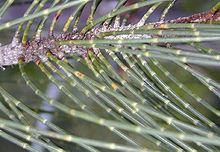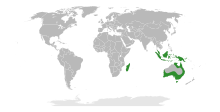The Casuarinaceae are a family of dicotyledonous flowering plants placed in the order Fagales, consisting of four genera and 91 species[2] of trees and shrubs native to eastern Africa, Australia, Southeast Asia, Malesia, Papuasia, and the Pacific Islands. At one time, all species were placed in the genus Casuarina. Lawrence Alexander Sidney Johnson separated out many of those species and renamed them into the new genera of Gymnostoma in 1980 and 1982,[3][4] Allocasuarina in 1982,[4] and Ceuthostoma in 1988, with some additional formal descriptions of new species in each other genus.[5] At the time, it was somewhat controversial. The monophyly of these genera was later supported in a 2003 phylogenetic study of the family.[6] In the Wettstein system, this family was the only one placed in the order Verticillatae. Likewise, in the Engler, Cronquist, and Kubitzki systems, the Casuarinaceae were the only family placed in the order Casuarinales.
| Casuarinaceae | |
|---|---|
 | |
| Common ironwood (Casuarina equisetifolia) | |
| Scientific classification | |
| Kingdom: | Plantae |
| Clade: | Tracheophytes |
| Clade: | Angiosperms |
| Clade: | Eudicots |
| Clade: | Rosids |
| Order: | Fagales |
| Family: | Casuarinaceae R.Br.[1] |
| Type genus | |
| Casuarina | |
| Genera | |
| |
 | |
| The range of Casuarinaceae | |
Members of this family are characterized by drooping equisetoid (meaning "looking like Equisetum"; that is, horsetail) twigs, evergreen foliage, monoecious or dioecious and infructescences ('fruiting bodies') cone-like, meaning combining many outward-pointing valves, each containing a seed, into roughly spherical, cone-like, woody structures. The roots have nitrogen-fixing nodules that contain the soil actinomycete Frankia.[7]
In Australia, the most widely used common name for Casuarinaceae species is sheoak or she-oak (a comparison of the timber quality with English oak). Other common names in Australia include ironwood, bull-oak or buloke, beefwood,[8] or cassowary tree.[9]
The Shire of Buloke in Victoria, Australia, is named after the species Allocasuarina luehmannii.
Systematics
Modern molecular phylogenetics suggest the following relationships:[10]
| |||||||
References
External links
 Data related to Casuarinaceae at Wikispecies
Data related to Casuarinaceae at Wikispecies Media related to Casuarinaceae at Wikimedia Commons
Media related to Casuarinaceae at Wikimedia Commons- Research team from IRD working on Frankia-Casuarinaceae mycorrhizal and nitrogen-fixing symbioses
- Diagne N, Diouf D, Svistoonoff S, Kane A, Noba K, Franche C, Bogusz D, Duponnois R (2013). "Casuarina in Africa: distribution, role and importance of arbuscular mycorrhizal, ectomycorrhizal fungi and Frankia on plant development". J Environ Manage. 128: 204–9. doi:10.1016/j.jenvman.2013.05.009. PMID 23747371.
- "Casuarinaceae R.Br". Atlas of Living Australia.

